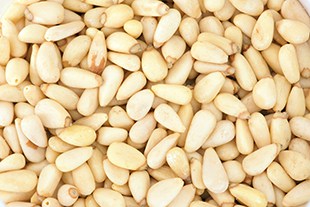Pinenuts Vs pine mouth
Pine nuts are those crunchy delectable seeds that are scattered over a summer salad, mixed in with the pesto, topping your favorite desert, pignoli or baklava. They usually have a sweet, buttery, resinous flavor. But some people can find them distasteful.
Some consumers complain of a bitter metallic taste in their mouth (metallogeusia), that begins 1-3 days after eating pine nuts and may persist up to 2 weeks before resolving. This phenomenon has become known as “pine mouth”, and is being increasingly reported across the world (1).
Over the past three years, the U.S. Food and Drug Administration have received over four hundred complaints of taste disturbances following the consumption of pine nuts (2). In France, more than a three thousand cases have been reported to poison centers over the past three years (3).
What are the health benefits of pinenuts?
Eating pine nuts is not a new thing. They have been a staple of Indigenous cuisine since Palaeolithic times, from Asia and Europe to the Americas. For their size, pine nuts are rich in calories, most of which comes from their high content of mono-unsaturated fatty acids (MUFA). A Mediterranean diet, which is rich in foods containing MUFAs, is thought to prevent heart disease by improving blood cholesterol levels and reducing inflammation. Pine nuts are also rich in dietary fiber, vitamins and minerals essential for good health. But why now, after centuries of salade landaise, are we finding pine nuts so disagreeable?
Jamie Oliver and rise of culinary experimentation are partly to blame. Over the last few years, more and more consumers are trying new ingredients and combinations to spruce up their food. Thanks to Gordon Ramsey, savvy patrons are also demanding more from their restaurant experience. Both have meant more pine nuts are being devoured than ever before. Flavor is a variable which is distributed around a mean value. While the majority of pine nuts will taste great, a small percentage will not. Multiply this by an explosion in their use in kitchens around the world, you have to expect a few more bad nuts.
Pine nuts are actually the edible seeds of pines trees. The seeds sit between the scales of the pine cone, and are released as the fertilized cone matures. Pine nuts are usually collected by harvesting and drying the pine cone, and then shaking the seeds free. The Korean Pine (Pinus koraiensis) from China represents the major source of pine nuts found in Australian supermarkets. These pine nuts are typically plump, teardrop shaped seeds. By contrast, seeds of the European stone pine (P. pinea) which are the staple of European cooking, are longer and look more torpedo-shaped than Chinese nuts.
Almost all of the people experiencing pine mouth had eaten pine nuts many times before, without problems. Often all those sharing the same product were affected. Such epidemiological data points to quality control. Increasing demand for pine nuts means shaking many more trees. Another theory for pine mouth is that someone somewhere picked up the wrong pine cone. Not all pine nuts are edible. Because a premium is paid for a good bag of nuts, it is widely believed that unscrupulous vendors have been passing off nuts not suitable for human consumption. For example, one study identified contamination with the inedible seeds of P. armandii in recent cases series of pine mouth (2,4). P.armardii is only used for building material.
Finally, because of their high fat content, pine nuts are best eaten fresh. They don’t store well. Once removed from their shell and exposed to light and air, their fats progressively become oxidized and the nut goes rancid. If you want to store them, they are best kept in the freezer, vacuum-packed, or in a dark, cool dry container. Never use those old nuts from the back of the pantry.
In essence, pine mouth is a symptom of globalization and mass production, where quality and safety are the inevitable cost. Pine nuts shouldn’t be fast food. Pine nuts are quintessentially a SLOW (sustainable, local, organic and whole) product to tickle the tastebuds, not damage them.
Last Reviewed 02/Mar/2014
Dr Merlin Thomas
Latest posts by Dr Merlin Thomas (see all)
- How to increase DHEA levels - 28/09/17
- Testosterone supplement benefits & risks - 11/07/17
- Health effects of tea & coffee - 10/07/17
